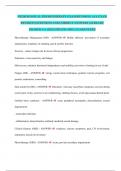NEUROLOGICAL PHYSIOTHERAPY EXAM REVISION. ALL EXAM
REVISION QUESTIONS AND CORRECT ANSWERS (ALREADY
GRADED A+) (2024 UPDATE) 100% GUARANTEED
Physiotherapy Management (MS) - ANSWER- Mildly affected; -prevention of secondary
impairments, emphasis on standing, gait & aerobic function
Exercise - reduce relapse rate & slower disease progression
Education - heat sensitivity and fatigue
Mod-severe; maintain functional independence and mobility, provision of training in use of aids
Fatigue (MS) - ANSWER- energy conservation techniques, gradual exercise programs, rest
periods, medication, counselling
Heat sensitivity (MS) - ANSWER- Education - heat may exacerbate symptoms, exercise during
cooler parts of day, exercise in air conditioning, clothing choices, avoid spas/saunas/heated pools
Guillain barre syndrome - ANSWER- acute peripheral neuropathy; demyelination, axonal
degeneration
- antecedent infection
- inflammatory demyelination, antibody mediated axonal damage
Clinical features (GBS) - ANSWER- weakness, sensory symptoms, pain, CN involvement,
respiratory muscle involvement
Physiotherapy (GBS) - ANSWER- Acute; prevent secondary impairments
,Cardiorespiratory management (GBS) - ANSWER- - respiratory muscle weakness
- physiotherapy techniques (BiPAP), airway clearance techniques (positioning, manual techniques,
suction, assisted cough)
Discharge Planning - ANSWER- The process of moving a patient from one level of care to
another. Involves patient, carer, family, staff members. Considerations; discharge destination,
prognosis, functional level, supports, waiting periods.
Slow Stream Rehab - ANSWER- - inpatient, 2-6 weeks, generally >65 years, Geriatric
Evaluation and Management Unit/ Geriatric Assessment Unit (GEM/ GAU), case management
and significant discharge planning, aged care assessment team (ACAT)
Fast Stream Rehab - ANSWER- Inpatient, - intensive therapy app. 3hrs per day (when fast
recovery expected and higher level of functional outcome), admitted from acute wards and
community, referral reviewed by rehabilitation specialists, generally younger
Low Level Care - ANSWER- Continence and cognition dependent, level of ambulation
required; independent with transfers and gait, access community therapy services (outpatient or
resident)
High Level Care - ANSWER- Discharge with care level that accommodates incontinence,
cognitive issues/dementia, assisted mobility
Home Based Rehab - ANSWER- Rehab for those unable to access community services,
generally aging population, home based goals
Center Based Rehab - ANSWER- Community Rehabilitation Center
,Community Health Center
Private
Post Acute Care (PAC) - ANSWER- - home-based, short-term service to fill gap period before
commencing other programs eg wait-list for community program, safety risk or functional
outcome will decline
Support Services for Home - ANSWER- Gov funded;
Neurological Physiotherapy - ANSWER- Reducing activity limitations and
participation restrictions and to
optimise quality of life for people who
experience disorders of the central
nervous system
Upper motor neuron (UMN) - ANSWER- collective term including all the descending
pathways that control the activities of the
neurons that supply the muscles (LMNs)
- originate in higher centres (i.e. motor cortex) & synapse with LMNs
Lower motor neuron (LMN) - ANSWER- motor neurons in the ventral (anterior) horns of the
spinal cord and in the motor nuclei of
the cranial nerves
- originate in the spinal cord & brainstem
, - directly innervate skeletal muscle
First order neurons (Sensory) - ANSWER- - activated in the periphery by sensory input (e.g.
touch,
proprioception, vision)
- can synapse with other sensory neurons (second- or third-order
neurons) for transmission towards the cortex, or with motor neurons
(e.g. reflexes)
Second order neurons (Sensory) - ANSWER- generally arise in the spinal cord or brain stem
- receive input from first order neurons in periphery
- send information to higher centres through synapses with third order
neurons
Third order neurons (Sensory) - ANSWER- - generally arise in the thalamus
- receive input from second order neurons
- project information to the cortex
Motor and descending pathways - ANSWER- Pyramidal tracts; lateral and anterior
corticospinal tracts
Extrapyramidal tracts; rubrospinal, reticulospinal, olivospinal, vestibulospinal tract
Sensory and ascending pathways - ANSWER- DCML; gracile and cuneate fasciculus




